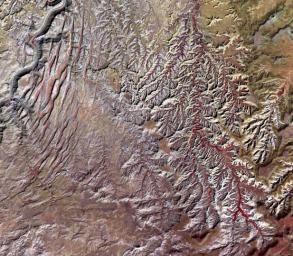Originally released on Oct. 7, 2013.
The desert southwest US is a showcase of geology. Canyonlands National Park in SE Utah is one such example. In this image, the Colorado River in the upper left corner forms the border of an area of outcrops of Permian (~280 million years old) Cedar Mesa Sandstone. Nearest the river, a series of arcuate faults has created a landscape of extremely narrow valleys. Further east a tributary of the Colorado has eroded the landscape into intricate feather-like drainage patterns. The image was acquired September 24, 2005, covers an area of 27 x 24 km, and is located near 38.1 degrees north latitude, 109.8 degrees west longitude.
With its 14 spectral bands from the visible to the thermal infrared wavelength region and its high spatial resolution of 15 to 90 meters (about 50 to 300 feet), ASTER images Earth to map and monitor the changing surface of our planet. ASTER is one of five Earth-observing instruments launched Dec. 18, 1999, on Terra. The instrument was built by Japan's Ministry of Economy, Trade and Industry. A joint U.S./Japan science team is responsible for validation and calibration of the instrument and data products.
The broad spectral coverage and high spectral resolution of ASTER provides scientists in numerous disciplines with critical information for surface mapping and monitoring of dynamic conditions and temporal change. Example applications are: monitoring glacial advances and retreats; monitoring potentially active volcanoes; identifying crop stress; determining cloud morphology and physical properties; wetlands evaluation; thermal pollution monitoring; coral reef degradation; surface temperature mapping of soils and geology; and measuring surface heat balance.
The U.S. science team is located at NASA's Jet Propulsion Laboratory, Pasadena, Calif. The Terra mission is part of NASA's Science Mission Directorate, Washington, D.C.
More information about ASTER is available at http://asterweb.jpl.nasa.gov/.

 Planetary Data System
Planetary Data System












